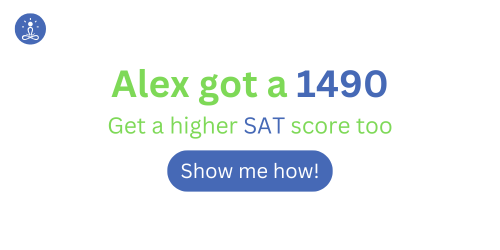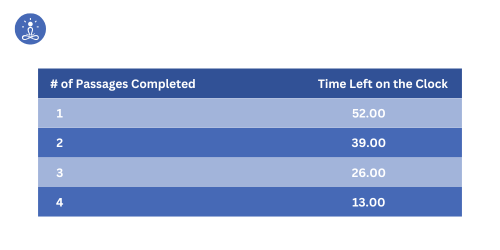The SAT reading section can be overwhelming for students new to it, given its dense passages and tricky questions. However, with a solid strategy, you can effectively tackle it. Here are ten top SAT reading tips to boost your score:
1. Familiarize yourself with SAT reading passage types.
2. Avoid reading every sentence.
3. Skim the passage before addressing questions.
4. Write paragraph summaries in the margins.
5. Use keyword skimming for specific questions.
6. Predict answers before checking options.
7. Be aware of common wrong answer traps.
8. Tailor strategies for each question type.
9. Use time checkpoints to stay on schedule.
10. When unsure, opt for the “boring” answer.
SAT Reading Tips for a High Score (2024)
1. Get Familiar With the Types of SAT Reading Passages
For achieving a high score in SAT Reading (2024), it’s crucial to understand the different types of SAT reading passages:
1. Literary narrative: These passages come from novels or stories.
2. Historical document: These are primary source documents like speeches, letters, or editorials.
3. Social science: These passages relate to the scientific study of human society and relationships, covering subjects such as anthropology, economics, or psychology.
4. Natural science: These passages delve into the scientific study of the physical world, typically covering topics in chemistry, physics, or biology.
During the test, you’ll encounter five passages, with literary fiction and historical documents appearing once each. Additionally, there will be either one social science passage and two natural science passages, or the reverse. One passage will include a graph, and another will consist of two short passages.
To prepare effectively, practice regularly with quality SAT reading materials to internalize this knowledge.
2. DON’T Read Every Sentence
The SAT reading approach differs significantly from our typical real-life reading habits. Reading every sentence in the passage is both time-consuming and unnecessary, creating an ineffective combination. Similarly, skipping directly to the questions without context isn’t ideal as it hinders reading comprehension. The recommended strategy is to skim through the passages instead.
3. Do a Preliminary Skim of the Passage Before Looking at the Questions.
Before delving into the questions, it’s crucial to skim through the passage. This isn’t a mere speed-read; it involves identifying and focusing on the key sentences while disregarding the rest (you can even cross out irrelevant sentences).

How can we discern the importance of a sentence? Generally, the first and last sentences of each paragraph are significant as they provide a summary of the paragraph’s content. However, there’s an exception: the first sentence of the overall passage often serves as a catchy introduction without substantial content.
Pay attention to transition words and phrases, as they indicate the structure of the passage. Sentences with contrast transitions (e.g., however, nevertheless, in spite of) or conclusion transitions (e.g., therefore, in conclusion, ultimately) are typically important. On the other hand, sentences with detail (e.g., in detail, for example, for instance) or continuation transitions (e.g., furthermore, additionally, in addition) can be skipped at this stage. The goal is to grasp the main ideas without getting bogged down in specifics.
4. Write a Summary in the Margins for Each Paragraph As You Progress
As you read the passage, pause after each paragraph and jot down a brief summary in the margins. Aim for brevity, ideally five words or less. You can even use symbols or abbreviations as long as you can understand your notes. Condensing multiple sentences into a few words may be challenging, but embracing this task will help you internalize and recall your summaries effectively, often eliminating the need to revisit them when answering questions.
Focus your summaries on key ideas, structure, and tone. Prioritize understanding relationships between concepts and perspectives over technical details. Your summaries should enable you to answer broader questions about the passage without revisiting the text.
5. Use Keyword Skimming for More Specific Questions
Specific questions in a passage require attention to detail, which is typically disregarded during the initial skim. However, keyword skimming offers a solution for answering these questions without re-reading the entire passage.
Start by identifying the most unique word in the question and scan for it in the passage. Your summaries can help pinpoint the paragraph likely to contain the answer. You don’t need to read the entire paragraph; instead, focus on the “shape” of the word, considering its length and distinctive letter patterns. Think of it as a “Where’s Waldo?” or “I Spy” game!
6. Predict Before Looking at the Answer Options
Students often have the instinct to read answer choices immediately after the question. However, on the SAT reading section, it’s more effective to first make a prediction of the correct answer before looking at the options. Even a vague prediction is better than none.
Predicting beforehand helps focus your thinking and reduces the risk of falling into wrong answer traps. Use your summaries to answer broader questions and base your predictions on them.
For specific questions, employ keyword skimming and focus on sentences containing your keyword. Use this information to refine your prediction. If you’re still unsure after reading the choices, reconsider your prediction and select the option closest to it.
7. Get familiar with the common wrong answer traps.
Incorrect answers on the SAT are designed to be deceiving. Here are common traps you may encounter:
1. Too broad: This answer is technically correct but doesn’t capture the passage’s meaning or content fully.
2. Too narrow: This choice includes a detail from the passage but cannot be generalized to the entire context.
3. Too extreme: These options are overly positive/negative or use absolute terms like “all,” “none,” “never,” or “every.”
4. Assumption: While possibly true, these answers aren’t necessarily supported by the passage.
5. Half right, half wrong: These choices are correct about one aspect but incorrect about another.
6. One word off: Almost perfect, but a single word makes it incorrect.
7. Wrong detail: Misinterprets or misattributed something from the passage.
8. Opposite: Contains a sneaky “not” or correctly answers a different question, like in “EXCEPT” questions.
8. Keep a Different Strategy in Mind for Each SAT Reading Question Type
Main Purpose questions focus on the overall meaning or intent of the passage or paragraph, allowing you to predict answers based on your summaries.
Line Reference questions refer to specific sentences, phrases, or words and ask about their intended meaning or purpose. Using the surrounding context helps in predicting answers.
Key Words questions inquire about specific details explicitly stated in the passage, often requiring keyword skimming to predict answers.
Inference questions deal with implicit notions in the text, demanding careful consideration and often requiring the process of elimination.
Evidence-Based Reasoning questions, often linked to Inference questions, ask for evidence from the passage supporting the inference made. Line references are provided to aid in answering these questions.
Vocabulary in Context questions explore the author’s use of words within the passage. Predictions for these questions should consider how the answer choices can substitute the word in question, requiring a broad knowledge of words with multiple meanings.
Graph questions involve interpreting graphics and connecting them back to the passage. Keywords from the graph can be used to scan the passage for relevant information.
Comparison Passage questions ask about relationships between paired passages. Answering questions about each passage individually before addressing joint questions is recommended, with skimming the first passage first for efficient answering.
9. Use Time Checkpoints to Stay on Track
During the SAT reading section, you’re allotted 65 minutes to tackle 52 questions. To manage your time effectively, avoid constantly checking the clock or neglecting your pace entirely. Instead, utilize time checkpoints to stay on track.

Since the questions are evenly distributed among the five passages, you can use these built-in checkpoints. Dividing 65 minutes by 5 passages gives you an average of 13 minutes per passage, including its corresponding 10 or 11 questions. This approach helps you allocate time appropriately and maintain a steady pace throughout the section. Adjustments can be made based on your strengths and weaknesses to ensure optimal time management.
10. When in Doubt, Choose the “Boring” Answer
Correct answers on the SAT reading section are typically not overly extreme or assertive in their implications or tone. Therefore, prioritize answers that are least assertive and most neutral. If you’re struggling with a passage or running short on time, utilize the process of elimination to improve your odds. Eliminate answers that are too exciting or assertive.
These are my top SAT reading tips to help you prepare effectively for the test.
All Tutorang SAT prep plans are designed to be digital and SAT-ready. Begin your study journey today!
